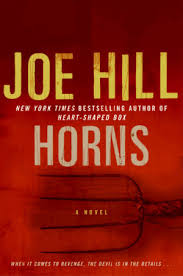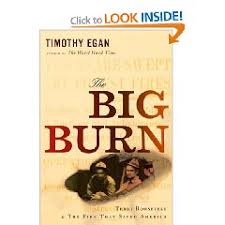Recently I finished the most recent Joe Hill book,
Horns. Now that he is a bestselling author and can (sorta) come out of his father's shadow (Stephen King), Hill is more willing to talk about himself in interviews.
Here is a good one from Time.
Now that I am done, I definitely think Horns is a horror book, but it is a slightly new breed, as I will explain in a bit, and I am wondering if it will start a trend. Okay, wait-- I am getting ahead of myself. Let's start with the plot.
Horns begins with our hero, Ig, waking up, hung over, with horns literally growing out of his head. It is about a year after his girlfriend was raped and murdered, a crime for which he was blamed, but never prosecuted. Turns out these horns have given Ig devilish powers. Basically every single person he comes into contact with cannot help but tell him all of their deepest secrets. And, when he touches them, he can see all the bad things they have done in their pasts.
You can imagine this makes for some interesting storytelling. Ig learns that just about everyone he knows believes he is guilty. Except, that he also learns who really killed his girlfriend. Here is where the story strays. We get lots of flashbacks to Ig's childhood, all which builds up details which explains the murder. We also start to get a bit of the killers point of view.
When we get back to present day Ig, he is living in the woods, calling together minions of snakes, and waiting to do battle with his girlfriend's killer. There is also an interlude of time warping which was interesting, but a bit forced. The ending is nonstop action and like most horror books, the story is resolved happily but the supernatural evil is not gone for good.
Overall, this was a highly entertaining read. The flashbacks were a bit slow for me, but compelling enough that I kept going. In the end, I had a thoroughly enjoyable reading experience.
Is this book a supernatural thriller or horror? I have thought about this a lot. I am going to go with horror. Why? Because even though Ig is the protagonist of the story, he is still a very scary dude. You are rooting for him, but at a distance.You would not want to meet him on any street, day or night. He defeats his very evil, totally human enemy, but he is still the devil; he can still breathe fire; and he is only building in strength. The entire book is unsettling and chilling. You never really have a chance to breathe easy while reading it. Which is not a bad thing.
So the next question I have is, will
Horns change the way horror novels are written? Will the hero begin to be someone/thing that we are as drawn to as we are afraid of? Generally, in a horror novel, the supernatural evil being is the obvious bad guy that our human protagonists fight against. What Hill has done, in terms of horror fiction, is very new. We will have to wait to see if it changes the genre at all though.
Other appeals: There are many detailed and interesting secondary characters here. This is pure small town horror. There is very little sex or violence, for the genre. You do get flashbacks and multiple points of view (hero and villain). The pace is swift and compelling in the present day story line, but a bit slower in the flashbacks. It is as if the present day moves at thriller pace, while the flashbacks move at literary fiction pace. Both are appropriate to their part of the story, but some readers may not like the shift in pacing.
The language is conversational and unembellished. There are funny inside jokes that refer to current popular culture, Hill's last novel, and his father's hatred of cell phones which fans will enjoy. The tone is bleak; bad things keep happening to Ig, and everyone around him holds on to very bad secrets. You might ask if anyone in your life is truly good after finishing this book. Turning into the devil isn't such a bad idea in this town. Finally, the ending is resolved but open.
Three Word to Decribe This Book: devil, storytelling-horror, character-centered
Readalikes: First of all, if you haven't read Hill's debut
Heart-Shaped Box or his even better (in my opinion) collection of stories,
20th Century Ghosts, run out to the library right now and get them.
Hill's writing is reminiscent of
his father's early work. I would suggest
The Shining specifically. I also think Hill's stories and novels are very similar to the award-winning
Pine Deep horror trilogy by Jonathan Maberry. I wrote about the first title,
Ghost Road Blues, at the end of this post.
Peter Straub (try
Ghost Story) and
Bentley Little (try
The Mailman) are also good choices for story-telling horror fans. These authors and those titles specifically have a wide appeal.
For writers who are a little less horrific, I would suggest
Dan Simmons and
Charlie Huston. Both have the dark humor, irony, and not so nice protagonists that mark Hill's work. Both are also on the edge of horror without completely crossing over the line into the darkness.
















